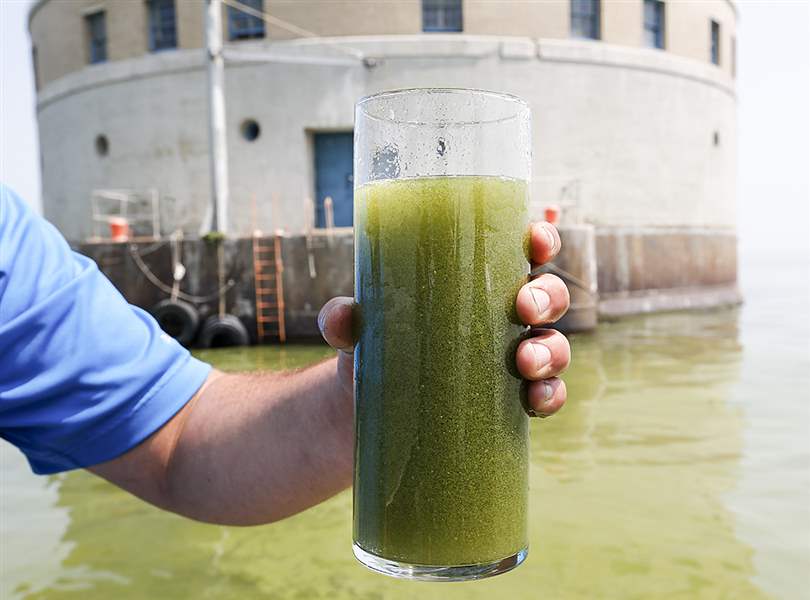
Toledo's Water Quality Dashboard moved to 'watch'
8/25/2017
Shane Gaghen of Oregon holds a glass of algae filled Lake Erie water, near the Toledo water intake crib, Sunday, August 3, 2014. Algal toxins were detected in the raw water from Lake Erie at the city’s intake crib on Friday.
THE BLADE
Buy This Image
The city of Toledo moved its “Water Quality Dashboard” needle from “clear” to “watch” Friday because algal toxins were detected in the raw water from Lake Erie at the city’s intake crib.
City spokesman Carrie Hartman said the drinking water is safe and there were no detectable levels of microcystin in treated water.
RELATED: Toledo's Water Quality Dashboard moved back to 'clear' status
Lake Erie algal toxins caused the 2014 Toledo water crisis that affected roughly 500,000 residents. The toxins also prompted Michigan in November, 2016, to declare portions of Lake Erie’s waters as impaired.
In 2016, the city spent $41 million as part of its 10-year, $500-million project to modernize the Collins Park Water Treatment Plant. An expected $122,400 will be spent treating Lake Erie water with chlorine this year.
Harmful algal bloom season officially started July 13, and the city started analyzing samples from Lake Erie on a daily basis the previous week. The Collins Park Water Treatment Plant collects daily samples year-round, but analyzes them once a week during the off-season.
“Today’s test results for microcystin indicate 7.45 [parts per billion] in untreated water at the intake crib in Lake Erie and nondetect in tap water,” Ms. Hartman said in a statement.
“Tap water is safe to drink,” she said. “The city’s water treatment process is effectively removing the microcystin. No action is required by consumers.”
The U.S. Environmental Protection Agency in May, 2015, said it is OK for the greatest segment of America’s population — those school-age and older — to drink tap water containing up to 1.6 parts per billion of microcystin. That amount is much more flexible than the World Health Organization guideline and the one most states, including Ohio, had previously used.
The limit for infants and children younger than age 6, pregnant women, nursing mothers, people with liver conditions, and those on dialysis, is 0.3 parts per billion. Those guidelines set aside 1998 World Health Organization recommendations of 1.0 parts per billion that states had been using while awaiting federal guidance.
The Ohio Environmental Protection Agency ordered the city of Toledo to declare the crisis in 2014 once the toxin level in tap water went above 1.0 ppb. It was found to be above 1.6 ppb during the ordeal, but not consistently.
The city's water-quality dashboard rates the water from clear to watch, caution, preschool advisory, and do not drink. The caution stage would mean microcystin has been detected in tap water but the level does not mandate an advisory.
Toledo officials held a news conference early this month to calm fears and assure the public they’re well-prepared to treat all toxins that enter the city’s Collins Park Water Treatment Plant.
The city has high-tech buoys and other instruments providing more advance notice of changing water conditions, and it is $130 million into the $500 million upgrade and expansion at Collins Park.
Andy McClure, the Collins Park plant’s administrator, stressed that Toledo’s water is safe to drink.
“We have been expecting it,” Mr. McClure said. “The predictions from back in June or July said there would be a big algae bloom. It was projected it to be comparable to 2013, which was bigger than 2014.”
Mr. McClure said the water treatment plant can handle “significantly more” algal toxins than it could in 2014.
“With the advance notice we have with the buoys, we are well-prepared,” he said.
Mr. McClure said the facility can produce toxin-free water when the lake water’s concentration is many times more than 5 ppb, but wouldn’t say how much more.
Toledo Mayor Paula Hicks-Hudson’s administration has been criticized by environmental groups for not joining them in urging the federal government to designate western Lake Erie’s open waters as impaired, a move that would direct the U.S. Environmental Protection Agency to apply tighter controls on all nutrient sources for algae — especially commercial agriculture.
Mayor Hicks-Hudson has repeatedly stated her resistance to an impairment status. She said she fears it could lead to higher sewage rates.
Lucas County Treasurer and Toledo mayoral candidate Wade Kapszukiewicz promised to push for more restrictions on polluters who dump untreated animal waste into Lake Erie by supporting the fight to declare the open waters of its western basin as impaired.
Toledo Councilman Tom Waniewski, a Republican who is also running for mayor, said earlier this year he was worried about the “public relations nightmare” an impaired designation could cause and that it is the wrong way to go.
Contact Ignazio Messina at imessina@theblade.com, 419-724-6171 or on Twitter @IgnazioMessina.